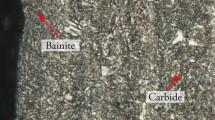Abstract
The fatigue strength of transverse butt-welded joints of SB410, SPV490 steels and SUS304-HP stainless steel was evaluated experimentally at R = −1, 0 and 0.5 and byσmax = σy tests. The yield strengths for the SB410, SPV490 and SUS304-HP were 284, 579 and 275 MPa. The fatigue strength was found to decrease at the higher R values, even up to around 0.8 in the case of the SPV490. In the case of SB410, the maximum stress at R = 0.5 usually exceeded the yield strength, and some of the fatigue strengths were lower than those obtained from the σmax = σy tests. The fatigue limit was slightly higher compared with that from the σmax = σy tests. In the case of the SUS304-HP joints, the maximum applied stress at R = 0.5 was higher than the yield strength even at the fatigue limit. Therefore, some of the fatigue strengths at R = 0.5 were lower than those from the σmax = σy tests. An empirical formula for the fatigue limit as a function of R, which should be applicable to stress-relieved welded structures, was derived.
Similar content being viewed by others
References
NRIM Data Sheet on Fatigue Properties for Butt Welded joints of SB42 Carbon Steel Plate for Boilers and Other Pressure Vessels -Effect of Stress Ratio-, No. 34, NIMS, Japan, (1983) 1–8.
NRIM Data Sheet on Fatigue Properties for Butt Welded joints of SPV50 Steel Plate for Pressure Vessels -Effect of Stress Ratio-, No. 40, NIMS, Japan, (1984) 1–8.
NRIM Data Sheet on Fatigue Properties for Butt Welded joints of SUS304-HP(18Cr-8Ni) Hot Rolled Stainless Steel Plate -Effect of Stress Ratio-, No. 53, NIMS, Japan, (1986) 1–8.
Ohta A., Maeda Y, Mawari T, Nishijima S. and Nakamura H: Fatigue Strength Evaluation of Welded Joints Containing High Tensile Residual Stresses, Int. J. Fatigue 8 (1986) 147–150.
Nakamura H, Nishijima S, Ohta A. Maeda Y., Uchino K., Kohno T. Toyomasu K and Soya I: A Method for Obtaining Conservative S-N Data for Welded Structures, J. Test. & Evaluation 16 (1988) 280–285.
Standard Method of Statistical Fatigue Testing, The Japan Society of Mechanical Engineers Standard S 002 (1981) 1–159.
Metallic Materials- Fatigue Testing- Statistical Planning and Analysis of Data, Annex C, International Standard ISO/DIS 12107(1997).
Fisher J.W: Fatigue Strength of Welded A514 Steel Beams, Proc. Conf. Fatigue of Welded Structures, The Welding Institute, 1 (1971) 135–148.
Gurney TR. and Maddox SJ: A Re-Analysis of Fatigue Data for Welded Joints in Steel, Welding Research International 3 (4), 1973, 1–54.
Author information
Authors and Affiliations
Rights and permissions
About this article
Cite this article
Ohta, A., Suzuki, N. & Maeda, Y. Shift of S-N Curves with Stress Ratio. Weld World 47, 19–24 (2003). https://doi.org/10.1007/BF03266374
Published:
Issue Date:
DOI: https://doi.org/10.1007/BF03266374




